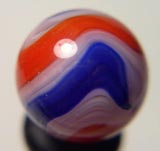Currencies
Information
More Information
Pattern Glass
Depression glass is clear or colored translucent machine made glassware that was distributed free, or at low cost, in the United States and Canada around the time of the Great Depression. Much depression glass is uranium glass. The Quaker Oats Company, and other food manufacturers and distributors, put a piece of glassware in boxes of food, as an incentive to purchase. Movie theaters and businesses would hand out a piece simply for coming in the door.
Most of this glassware was made in the Ohio River Valley of the United States, where access to raw materials and power made manufacturing inexpensive in the first half of the twentieth century. More than twenty manufacturers made more than 100 patterns, and entire dinner sets were made in some patterns. Common colors are clear (crystal), pink, pale blue, green, and amber. Less common colors include yellow (canary), ultramarine, jadeite (opaque pale green), delphite (opaque pale blue), cobalt blue, red (ruby & royal ruby), black, amethyst, monax, and white (milk glass).
Although of inferior quality to elegant glass, Depression glass has been highly collectible since the 1960s. Due to its popularity as a collectible, Depression glass is becoming more scarce on the open market. Rare pieces may sell for several hundred dollars. Some manufacturers continued to make popular patterns after World War II, or introduced similar patterns, which are also collectible. Popular and expensive patterns and pieces have been reproduced, and reproductions are still being made.
Pattern Glass is a broad category of mostly machine manufactured "pressed" glass pattern dinnerware sets and stemware that is typically broken out into the major categories of Early American Pattern Glass (EAPG), Needle Etch, Carnival, Depression, and Elegant Glass.



 Buy Akro Agate Popeye marbles on eBay!
Buy Akro Agate Popeye marbles on eBay!